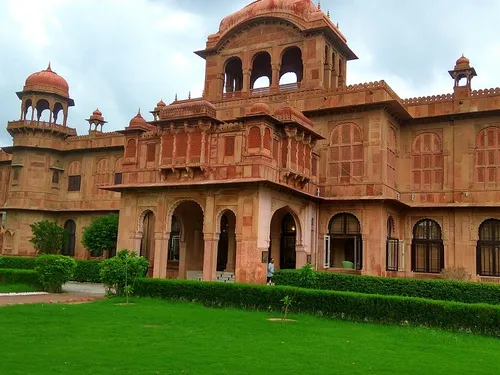
Lallgarh Palace and Museum: A Glimpse into Bikaner
Located in the historic city of Bikaner, Rajasthan, Lallgarh Palace and Museum stands as a grand testament to the opulence and architectural brilliance of the Rajput era. This majestic palace, with its rich history and cultural significance, offers visitors a unique opportunity to explore the regal heritage of the Bikaner royal family. Here’s an in-depth look at Lallgarh Palace and Museum, exploring its history, architectural features, and what makes it a fascinating destination.
A Historical Overview
Lallgarh Palace was built between 1902 and 1926 by Maharaja Ganga Singh, the then ruler of Bikaner. The palace was constructed as a royal residence and a symbol of the Maharaja’s grandeur and taste. Designed by the British architect Sir Samuel Swinton Jacob, the palace reflects a blend of traditional Rajput architecture with European influences, showcasing the Maharaja’s desire to combine local craftsmanship with modern design elements.
In addition to serving as a royal residence, Lallgarh Palace was also utilized for various royal functions and ceremonies. Over the years, the palace has been transformed into a museum, preserving its rich heritage and offering visitors a glimpse into the royal lifestyle of Bikaner.
Architectural Splendor
Design and Structure
Lallgarh Palace is renowned for its unique architectural style, which combines Rajput, Mughal, and European influences. The palace’s design is characterized by its intricate carvings, expansive courtyards, and lavish interiors.
Facade and Entrance: The palace features a grand facade with ornate carvings and decorative elements. The entrance is adorned with intricate latticework, arches, and columns, reflecting the artistic craftsmanship of the time.
Interior Elegance: The interiors of Lallgarh Palace are equally impressive, with opulent rooms and suites featuring luxurious furnishings, rich fabrics, and detailed artwork. The palace’s design incorporates traditional Rajput elements such as jharokhas (balconies) and intricate marble inlays.
Courtyards and Gardens: The palace includes several spacious courtyards and gardens, each designed to enhance the palace’s grandeur. These spaces feature decorative fountains, manicured lawns, and a variety of floral arrangements.
Notable Features
Intricate Carvings: The palace’s facade and interiors are adorned with detailed carvings and decorative motifs. The use of red sandstone and marble adds to the palace’s elegance and grandeur.
European Influences: The palace’s design incorporates European architectural elements, including high ceilings, large windows, and elaborate interiors. This blend of styles creates a unique and harmonious aesthetic.
Royal Collection: The museum within the palace houses a rich collection of royal artifacts, including paintings, weapons, and textiles. These items provide valuable insights into the lifestyle and culture of the Bikaner royal family.
Cultural and Historical Significance
Lallgarh Palace holds significant cultural and historical value as a symbol of Bikaner’s royal heritage. It represents the opulence and sophistication of the Rajput rulers and provides valuable insights into their lifestyle and traditions.
Key Attractions
Architectural Grandeur: The palace’s unique blend of Rajput, Mughal, and European architectural styles highlights the artistic achievements of the time. Its intricate carvings and lavish interiors are particularly noteworthy.
Royal Museum: The museum within the palace features a diverse collection of royal artifacts, including portraits, antique weapons, and traditional textiles. The museum offers a glimpse into the regal lifestyle and cultural heritage of the Bikaner royal family.
Historical Insights: Exploring the palace provides valuable insights into the history of Bikaner and its rulers. The palace’s design and artifacts reflect the region’s rich cultural and artistic heritage.
Tips for Visitors
Timing: Lallgarh Palace and Museum are generally open to visitors throughout the week. It’s advisable to check specific visiting hours and any special events before planning your visit.
Dress Code: Wear comfortable and respectful attire, considering the cultural and historical significance of the site. Comfortable footwear is recommended due to the walking involved.
Guided Tours: Hiring a local guide can enhance your visit by providing detailed information about the palace’s history, architecture, and significance. Guides can offer valuable insights and anecdotes that bring the palace’s history to life.
Photography: Photography is usually allowed, but be mindful of any restrictions, especially inside the museum.
Lallgarh Palace and Museum in Bikaner is a captivating destination that offers a glimpse into the grandeur and elegance of Rajasthan’s royal heritage. Its unique architectural design, lavish interiors, and rich collection of royal artifacts make it a memorable and enriching experience for visitors. As you explore its grand courtyards, admire its artistic details, and immerse yourself in its historical significance, you’ll gain a deeper appreciation for the opulence and charm of Bikaner’s royal past. A visit to Lallgarh Palace promises an unforgettable journey through one of Rajasthan’s most iconic and historic landmarks.
